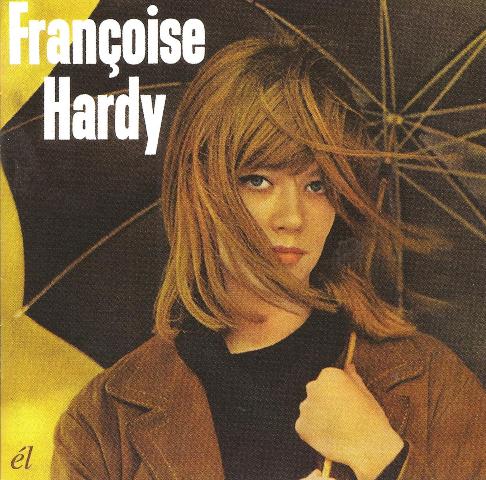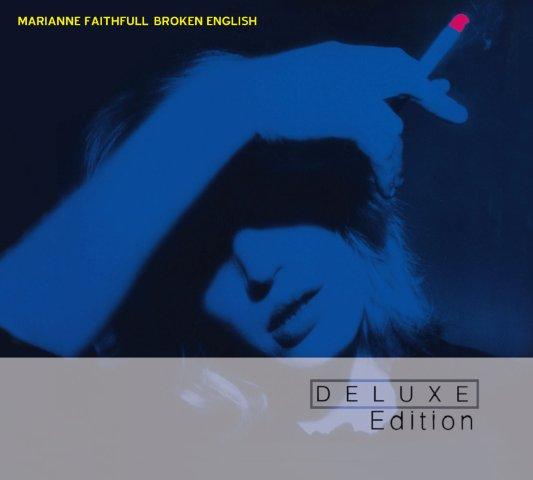Reissue CDs Weekly: Marianne Faithfull, Françoise Hardy, Pia Fraus | reviews, news & interviews
Reissue CDs Weekly: Marianne Faithfull, Françoise Hardy, Pia Fraus
Reissue CDs Weekly: Marianne Faithfull, Françoise Hardy, Pia Fraus
A revitalised Sixties survivor, the tentative early days of a French icon and top-notch indie from an unlikely quarter

In 1979, there was no obvious place for Marianne Faithfull. Identified with the Sixties and the baggage which came from her relationship with Mick Jagger, she had spent part of the decade living on a wall in Soho, a drug addict with few prospects, a period harrowingly detailed in her autobiography. There was an album in 1976, the humdrum, country flavoured Dreamin’ my Dreams, but punk, surprisingly, offered a life line. She appeared on stage with pop-punkers The Boys and, in 1979, issued the extraordinary Broken English, which sounded of its time yet didn’t side-step the past. It still sounds fresh.
An exemplary reissue, this deluxe edition of Broken English does the job properly. Patrick Humphries’ liner notes tell the story and more. The second disc is a previously unheard version of the album, the unadorned basis of what was finally issued. Also included is Derek Jarman's film made for the album (in MP4 format), a version of “Sister Morphine” originally issued on a compilation and as a B-side, and the single version of the title track.
'The Ballad of Lucy Jordan' was at one with the dark clouds gathering over music in the wake of punk
Broken English was trailed by the single of Faithfull’s synth-driven cover of Shel Silverstein’s "The Ballad of Lucy Jordan", which nominally built on the country angle of Dreamin’ my Dreams. That the song had then most recently been tackled (in 1976) by Lee Hazlewood telegraphs the darkness inherent to its appeal. The story of a descent into a maelstrom, in Faithfull's hands it seemed like an alternative, yet believable, take on her own life (it later cropped up on the soundtrack to Thelma and Louise – the promo video for the single is seen at the end of this). Pin-sharp, it was laceratingly at one with the dark clouds gathering over music in the wake of punk.
The album followed. Attention focused on her razor-edge take of John Lennon’s “Working Class Hero” - discussed trenchantly in the liner notes – and its closing track, a sonic open wound called “Why D’ya Do It?”. Explicitly drawing from Hendrix’s version of Dylan’s “All Along the Watchtower”, it set Heathcoat Williams’ words to music. Although lyrics like "'Why'd ya do it?', she said, 'Why'd you let her suck your cock?'” and “every time I see your dick, I see her cunt in my bed” attracted attention and the ban of the song in some territories, it’s a recording of rare majesty and beauty.
Overall, Broken English was sequenced to build up to that pay off. It still compels. The lost, first version of the album brings new insight. It’s not so much a demo, but finished recordings with a traditional band that were subsequently made over with new rhythms and the addition of synthesisers played by her Island Records label mate Steve Winwood.
Faithfull has said she considers the released album overproduced. Comparing the issued with the shelved doesn’t undermine the released version of the album. They are different. For now a least, the familiar has the edge. Time and living with this may alter the balance. The package is further enhanced by Derek Jarman’s Kenneth Anger-influenced film, which visually captures the album’s turmoil. Indispensable.
 Françoise Hardy: Françoise Hardy
Françoise Hardy: Françoise Hardy
Françoise Hardy instantly hit in 1962 with the frail, folky and self-penned “Tous les Garçons et les Filles”, an elegy sung from the perspective of someone surrounded by love, yet excluded from it. At this formative stage in the pre-Beatle era, she was a rarity – setting the singer-songwriter template in parallel with Bob Dylan. French pop in 1962 didn’t have a ready infrastructure, with session musicians and quality studios on hand, so all these songs and performances sound thin, but they do enchant. She quickly went international and also provided the template Rolling Stones' manager Andrew Loog Oldham worked from when propagating Marianne Faithfull. Hardy’s potential suitors included Mick Jagger and Dylan. The skimpy liner notes tell little about the time, the context and Hardy herself. They are more concerned with the Dylan link. More problematic is that this reissues her first album - albums were a side issue in French pop at the time. Four track EPs – le super 45 – were how Hardy was heard back then. Once three had been released, the 12 tracks were collected to become an album - standard practice in France until 1967, when albums as entities in their own right began being issued. Reconfiguring these tracks as a collection of her early EPs would have been more coherent and true to her history. The impact is diluted further by including contemporary Italian-language recordings that are even more irrelevant to any appreciation of Hardy.
 Pia Fraus: Silmi Island (Compilation 1998-2008)
Pia Fraus: Silmi Island (Compilation 1998-2008)
Although the name is obscure and the country they are from somewhat less so, the music of Estonia’s Pia Fraus is hardly alien. This lovely career-spanning compilation amply makes the case for the five-piece band as one of the planet’s top-notch exponents of shoegazing, dream pop or whatever it’s called. Over 15 elegant blissed-out, warmly fuzzy airs, My Bloody Valentine, Slowdive and early Pastels are invoked but don’t submerge a band whose unique voice is dreamier, more lilting – folkily so - than their inspirations. “Japanese Heart Software” is a waking dream, while “Sailing Yes” sounds like a forgotten classic. Although three tracks - “Deep Purple Girl”, “No Need For Sanity” and “400 & 57” - are recent re-recordings specially made for this comp, this flows like a real album rather than a grab-bag retrospective. With a popified take on My Bloody Valentine’s “Strawberry Wine” as a bonus track, Silmi Island demonstrates that geography is no barrier to producing world-class goods. Incidentally, the title comes from an island adjacent to South Korea’s Incheon Airport.
Watch the video for "The Ballad of Lucy Jordan", from Marianne Faithfull's Broken English
Buy
Share this article
The future of Arts Journalism
You can stop theartsdesk.com closing!
We urgently need financing to survive. Our fundraising drive has thus far raised £49,000 but we need to reach £100,000 or we will be forced to close. Please contribute here: https://gofund.me/c3f6033d
And if you can forward this information to anyone who might assist, we’d be grateful.

Subscribe to theartsdesk.com
Thank you for continuing to read our work on theartsdesk.com. For unlimited access to every article in its entirety, including our archive of more than 15,000 pieces, we're asking for £5 per month or £40 per year. We feel it's a very good deal, and hope you do too.
To take a subscription now simply click here.
And if you're looking for that extra gift for a friend or family member, why not treat them to a theartsdesk.com gift subscription?
more New music
 First Person: Musician ALA.NI on how thoughts of empire and reparation influenced a song
Usually singing about affairs of the heart, ALA.NI explains how new song "TIEF" originated
First Person: Musician ALA.NI on how thoughts of empire and reparation influenced a song
Usually singing about affairs of the heart, ALA.NI explains how new song "TIEF" originated
 Album: The Divine Comedy - Rainy Sunday Afternoon
Neil Hannon takes stock, and the result will certainly keep his existing crowd happy
Album: The Divine Comedy - Rainy Sunday Afternoon
Neil Hannon takes stock, and the result will certainly keep his existing crowd happy
 Music Reissues Weekly: Robyn - Robyn 20th-Anniversary Edition
Landmark Swedish pop album hits shops one more time
Music Reissues Weekly: Robyn - Robyn 20th-Anniversary Edition
Landmark Swedish pop album hits shops one more time
 Album: Twenty One Pilots - Breach
Ohio mainstream superstar duo wrap up their 10 year narrative
Album: Twenty One Pilots - Breach
Ohio mainstream superstar duo wrap up their 10 year narrative
 Album: Ed Sheeran - Play
A mound of ear displeasure to add to the global superstar's already gigantic stockpile
Album: Ed Sheeran - Play
A mound of ear displeasure to add to the global superstar's already gigantic stockpile
 Album: Motion City Soundtrack - The Same Old Wasted Wonderful World
A solid return for the emo veterans
Album: Motion City Soundtrack - The Same Old Wasted Wonderful World
A solid return for the emo veterans
 Album: Baxter Dury - Allbarone
The don diversifies into disco
Album: Baxter Dury - Allbarone
The don diversifies into disco
 Album: Yasmine Hamdan - I Remember I Forget بنسى وبتذكر
Paris-based Lebanese electronica stylist reacts to current-day world affairs
Album: Yasmine Hamdan - I Remember I Forget بنسى وبتذكر
Paris-based Lebanese electronica stylist reacts to current-day world affairs
 theartsdesk on Vinyl 92: Marianne Faithful, Crayola Lectern, UK Subs, Black Lips, Stax, Dennis Bovell and more
The biggest, best record reviews in the known universe
theartsdesk on Vinyl 92: Marianne Faithful, Crayola Lectern, UK Subs, Black Lips, Stax, Dennis Bovell and more
The biggest, best record reviews in the known universe
 Blondshell, Queen Margaret Union, Glasgow review - woozy rock with an air of nonchalance
The singer's set dripped with cool, if not always individuality
Blondshell, Queen Margaret Union, Glasgow review - woozy rock with an air of nonchalance
The singer's set dripped with cool, if not always individuality
 Music Reissues Weekly: Chiswick Records 1975-1982 - Seven Years at 45 RPM
Triple-album 50th-anniversary celebration of the mould-breaking British independent label
Music Reissues Weekly: Chiswick Records 1975-1982 - Seven Years at 45 RPM
Triple-album 50th-anniversary celebration of the mould-breaking British independent label


Add comment